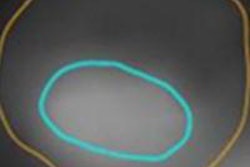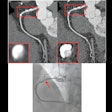Coronary CT angiography does detect coronary atherosclerosis, but today's energy-integrating detectors (EIDs) are limited by noise and insufficient contrast-to-noise ratios (CNRs), and they require relatively high radiation doses, Jochen Cammin, PhD, explained to AuntMinnie.com.
CT with photon-counting detectors is inherently less noisy than EID-CT, and it offers opportunities for dose reduction by making "better use of the energy information enclosed in the transmitted x-ray spectrum, increasing tissue CNR, and even allowing for molecular imaging when combined with nanoparticle contrast agents," he said.
The study team conducted simulation studies using a phantom and both a photon-counting detector with realistic spectral distortions and an EID. The phantom was modified to simulate both calcified and vulnerable plaque, and the images were reconstructed using standard filtered back projection. Plaque detection was based on pixel regions of interest.
In each of the configurations, the ability to detect vulnerable coronary plaque was better for the photon-counting detector than the EID, and compensation for spectral distortion in the photon-counting detectors further improved the detectability, the group reported.
The results of the study imply that CT with a photon-counting detector with compensation may outperform current EID-CT by a factor of three in contrast-to-noise ratio for soft plaque and a factor of five in contrast-to-noise ratio for vulnerable plaque marked with nanoparticle contrast agents. The results will only improve with the development of better algorithms and CT detectors, Cammin added.



















